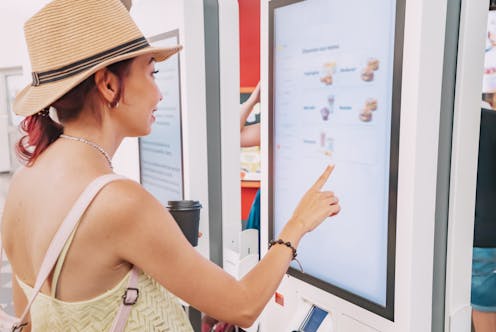Why restaurant self-service kiosks can actually result in customers ordering less food
New research on food-ordering kiosks introduces the social dynamics at play and offers alternatives for designing a more effective and customer-friendly self-service process.

When restaurant customers order from a self-service kiosk while a line forms behind them, they feel rushed, prompting them to buy less and stick to familiar items instead of browsing for something new, according to a recent study we published.
We found that businesses can reduce this pressure and increase satisfaction by revamping their system so that a single line of waiting customers leads to multiple kiosks. That way, customers feel less rushed because they aren’t the only ones who may be holding up the line.
We are experts in food and beverage marketing who research self-service technology. In recent years, many restaurants have adopted automated technology to streamline the menu ordering process and address staffing shortages. This ultimately gives customers more control over ordering, but an unintended consequence of this has seemed to be that it also makes them feel more responsibility for keeping the line that forms behind them moving, leading to rushed orders.
To understand what’s going on, we conducted three experiments in which we asked hundreds of participants to imagine waiting in line at a restaurant in a variety of scenarios. We found that most people do in fact feel pressured to order quickly when there’s a queue behind them. This resulted in hasty decisions and lower overall spending.
But we also found that retailers can mitigate this in one of two ways: by creating a single line serving several kiosks or by showing a pop-up message on the kiosk interface stating that the business takes full responsibility for any service delays during menu orders.
Our research reveals the social dynamics at play in do-it-yourself ordering and we believe offers valuable implications for designing a more effective and customer-friendly self-service process. It also alerts restaurant owners to the potential unintended consequences of switching to automated technology.
The authors do not work for, consult, own shares in or receive funding from any company or organization that would benefit from this article, and have disclosed no relevant affiliations beyond their academic appointment.
Read These Next
Winter storms blanket the East, while the U.S. West is wondering: Where’s the snow?
Here’s what snow forecasters are watching, and why skiers and other snow lovers shouldn’t lose hope.
Stalin’s postwar terror targeted Soviet Jews – in the name of ‘anti-cosmopolitanism’
Thirteen Jewish leaders and artists were killed on the ‘Night of the Murdered Poets,’ one of the…
Speaker Johnson’s choice to lead by following the president goes against 200 years of House speakers
The founders’ vision of the speaker of the House – a nonpartisan moderator and referee – has yielded…






